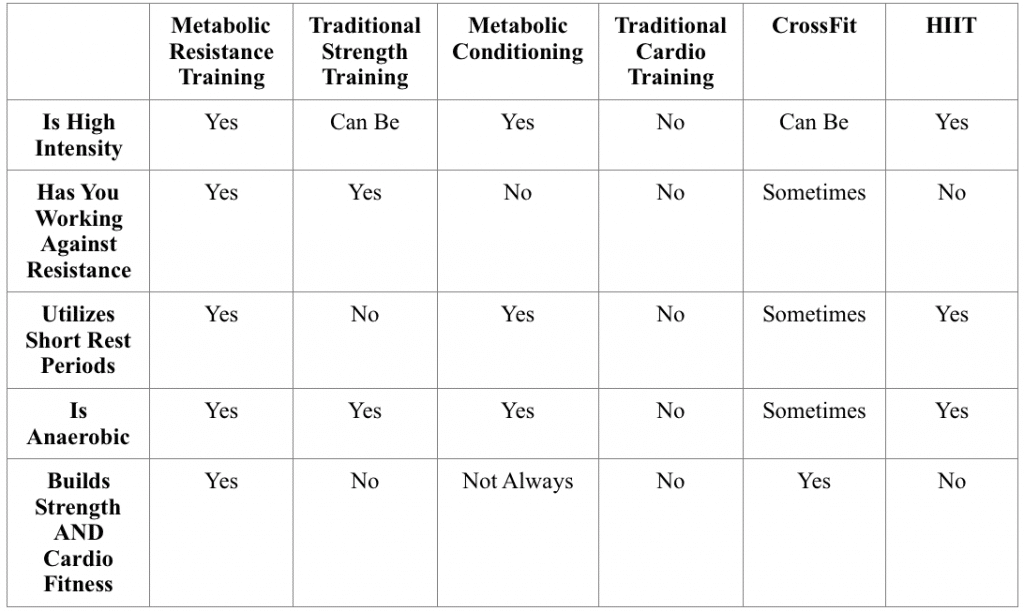In this article
Note: This is a guest post by Wayne Lightheart
With countless numbers of workout programs out there, do you feel confused and overwhelmed with deciding which is best for you?
If so, you aren’t alone. In today’s fat-loss world, there is a sea of endless workouts you can do.
You’ll find everything from 4-minute Tabata workouts to 60-minute steady-state cardio plans.
Which will deliver you optimal results? Which will give you the most optimal return for your time investment?
If you have not heard of metabolic resistant training (MRT) workouts yet, it’s time to sit up and pay attention to this. It is the future of fat loss training, and includes functional training exercises that will make you stronger not just in the gym, but for everyday life.
Let’s look at what you need to know about metabolic training workouts and how you can get started, to take your results to the next level.
What is an MRT Workout?
First things first, let’s discuss what metabolic training actually is.
Metabolic training involves staggering multiple exercises together in order to create an oxygen debt. The rest periods are extremely short and the intensity is relatively high.
By performing multiple metabolic training exercises sequentially for different muscle groups, you can actively rest one muscle group while pushing another with little to no rest between exercises.
This style of metabolic conditioning workout simultaneously provides a high-intensity resistance training workout combined with a high-intensity aerobic and a high-intensity lactic acid threshold workout.
Ideally you will build up to the point in your workouts where you will be working so hard that you push your body into oxygen debt.
That oxygen debt will allow you to continue to burn calories long after the workout is finished.
Eek Out the EPOC
When you take your exercise intensity to very high levels, you’ll create in the body what’s often referred to as EPOC, or excess post exercise oxygen consumption.
By now, you may know the difference between aerobic exercise and anaerobic exercises.
Aerobic exercises refers to exercise done in the presence of oxygen. This is your everyday stroll, a steady-state cardio session, or anything else that gets you moving but doesn’t elevate your heart rate too terribly much.
Anaerobic exercise, on the other hand, is done without the presence of oxygen. Essentially, you are exercising so hard that you are putting more demands for oxygen on the body than it can keep up with. As such, you create an oxygen deficit.
EPOC comes into play because as this oxygen deficit is created, it will then have to be replenished. That happens when you’re done exercising.
So after that ultra-intense anaerobic activity, your body will continue using oxygen at a faster rate, trying to recover.
And this is what helps elevate your resting metabolic rate, hence the term, metabolic training.
In order for exercise to be considered metabolic training, it needs to meet these three criteria:
- Total body movements are being performed
- You are working at a near maximum level of intensity
- You begin to “feel the burn,” which is the development of lactic acid in the muscle cells
Now, we’ve gone and added another element to this, making it metabolic resistance training (MRT).
Getting Specific with MRT Workouts
Metabolic resistance training is taking the concepts required for metabolic training and using resistance training to get the job done.
This means you take compound heavy weight lifting exercises and begin to stack them back to back, with little to no rest between sets.
This helps you satisfy all three requirements above effectively. You’ll be working multiple muscle fibers at once, you’ll be working at a near maximum level of intensity, and due to the lack of rest you’ll be taking, you will surely develop a good degree of lactic acid build-up.
How does this differ from other intense workout styles?
Here’s a quick comparison.
All in all, metabolic resistance training gives you the best of all worlds. Unlike other forms of training, it not only improves both your cardio as well as your strength levels, but it does so while getting you in and out of the gym quickly.
A proper metabolic resistance training workout should take around 20 to 30 minutes to complete.
Compare this to your average strength training workout coupled with a cardio session after, which would also work both your strength and cardio fitness levels. You’d likely spend 45 minutes or so doing your strength training program and then another 30-45 minutes doing your cardio training.
The end result is that you are easily in the gym for 75-90 minutes. Few people have time for all that, so metabolic resistance training helps you get fit and maintain sufficient time in your life for all your other commitments.
Who Should Do Metabolic Conditioning Workouts
Now that you know a little more about what metabolic training is, who would be best suited to doing it?
Just about everyone is well suited to doing metabolic resistance training. Some of the individuals who will most benefit include anyone who:
- wants short but highly effective workout sessions.
- is looking to burn fat as quickly as possible while maintaining lean muscle mass.
- wants to gain muscular strength but stay very lean at the same time.
- hopes to boost their cardiovascular fitness level.
- is looking to increase their overall strength.
- has limited time to work out.
- wants to feel more athletic versus just looking good (although make no mistake, metabolic resistance training will have you looking great too!).
- is ready to take their training to the next level and want to feel more challenged.
- needs additional conditioning in their sport specific training sessions.
As you can see, metabolic resistance training really can benefit just about everyone.
There are only a few people who should avoid metabolic resistance training or at the very least, move forward carefully.
The first of those people are those who are coming off an injury. Make no mistake about it, metabolic resistance training is very intense. If you aren’t able to exercise at the intensity level called for by the workouts, you simply won’t see the results these workouts have to offer.
Because of this, going forward to do metabolic resistance training may have you back injured again, so you should wait until you are fully recovered before getting into this.
The second group of people who might want to refrain from doing metabolic resistance training workouts are those who are just getting started with their fitness journey.
As noted, this is a very intense form of exercise and unless you have a good base of strength and resistance training experience, it will likely be too intense for your body.
Beginners could be at risk of overtraining or experiencing injury if they rush into it, so care must be taken. Spend 6 months (or longer, depending on your own conditioning level) building up that base first.
Then you can move forward and begin your metabolic resistance training.
Finally, the third group of individuals who may want to refrain from doing metabolic resistance training are those who are unable to exercise at high intensity levels due to any sort of health issue or situation they are in.
For instance, if you currently have heart health problems and have been recommended by your physician to exercise only at moderate intensity levels, metabolic resistance training is not for you.
Likewise, if you are currently pregnant and therefore need to temporarily scale back on your intensity level, this style of training is also not likely for you.
If you have any questions or concerns about this, always speak to your physician first.
The Benefits of Metabolic Conditioning
Before we get into the details of what a metabolic resistance training session would look like, let’s talk benefits. What do you stand to gain from doing metabolic resistance training?
Here are some of the key benefits to know about.
1. Accelerated fat burning
There’s no denying the fact that when you compare a standard strength training program to a metabolic resistance training program, the metabolic resistance training protocol will come out ahead.
When studies look at those performing steady state exercise sessions done at a moderate pace and those doing interval training types of workouts, the interval groups show superior rates of total body fat burning and also often show greater fat loss especially from the trunk/core region (1).
As this is the body fat that is most dangerous to your health, this also means that metabolic resistance training may help prevent some of these unwanted conditions.
2. Improved cardiovascular fitness level
To improve your cardiovascular fitness level, you need to perform exercise that elevates your heart rate and keeps it elevated. MRT will do this perfectly.
Despite the fact you may be taking short rest periods during your session, you’ll still keep your heart rate elevated enough to improve cardiovascular conditioning.
What’s more is that this type of training may also boost your VO2 max, which represents how much oxygen your body is able to utilize at a given exercise intensity level (2).
If you happen to participate in intense sports, this will provide direct transfer over benefits to becoming a better athlete.
3. Increased muscular strength level
Since metabolic resistance training has you utilizing resistance training exercises, you’re also going to see an excellent improvement in your muscular strength level.
This is unlike other cardio-based forms of HIIT, which may provide the metabolic boost that MRT does, but will not give you this kind of muscular strength improvement.
4. Decreased time commitment
As noted above, metabolic resistance training is a fast way to train. You can be in and out of the gym in 30 minutes or less, so this is a big benefit for those who lead busy lifestyles or have other commitments vying for their time.
Because with metabolic resistance training you’ll also be using compound exercises that work multiple muscle groups at once, you’ll also typically train the entire body in a single session.
This means that with three workouts per week (with one day between sessions), you can be forming a very thorough workout protocol.
There’s no need to hit the gym four to five times as you may have with a split body, more bodybuilding-style workout approach.
And, since you are reaping those cardiovascular benefits as well with metabolic resistance training, you can stop doing so many additional cardio workouts on top of this.
5. Improved insulin sensitivity levels
Insulin sensitivity is an important factor of your health to take into account as it can influence your risk of weight gain as well as your risk factor for developing diabetes, along with a number of other conditions.
Here again, metabolic resistance training really shines. With each session you do, you’ll improve how responsive your cells are to insulin, ensuring that you are better equipped to keep your blood glucose levels in a safe and healthy range.
In one study, researchers had a group of sixteen young otherwise healthy men partake in a program that consisted of just 15 minutes total of high intensity exercise. After the two week trial period was over, all subjects showed increased levels of insulin sensitivity along with a higher aerobic performance as well (3).
6. Lower stress
Intense exercise training also tends to lower stress levels, while boosting your mood.
Once you get started with metabolic resistance training and begin working at the intensity level called for in these workouts, you will soon come to see just how effective they are at boosting your mood.
You’ll come out of each session feeling more relaxed, rejuvenated, and almost always with a lower overall stress level.
7. Improved sleep quality
Finally, as with any exercise training, metabolic resistance training has the potential to increase sleep quality as well as duration.
As the intensity of exercise is increased, the sleep boosting benefits also increase, provided the exercise is performed early enough in the day that there is no interference with the ability to fall asleep.
If you perform your metabolic resistance training too close to bed time, you may find it harder to get to bed at night, so just be mindful of what time you plan to do your training.
Those are just a few of the key tips and benefits that you have to gain from getting involved in metabolic resistance training. It really is a very beneficial type of workout program that you’ll want to consider taking advantage of.
A Sample MRT Workout
So how should you structure your metabolic exercises? What does a typical metabolic resistance training workout session look like?
Below you’ll find a sample metabolic conditioning circuit, which you can do one to three times through, based on your fitness level.
It features a number of exercises done back-to-back. A good option for beginners is to choose a few of these exercises to start with, and build up as you get fitter.
Or, you can switch and swap the exercises to suit your needs on any given day
Rest for as little as possible between circuits. For beginners, the rest period might be 1 to 2 minutes, while for more advanced exercises, it might be 20 seconds or less.
For exercises that use weights, use one that is heavy enough so that it challenges you by the time that you get to the last rep. That said, here are some round-by-round guidelines for weight choice and pacing yourself:
First round: 70 percent of your maximum output
Second round: 80 percent to 90 percent of max output
Third round: 90+ percent of max output
- Squats, 10-20 reps
- Stationary lunges, to failure (or 10 reps each side)
- Jump lunges, to failure (or 10 reps each side)
- Jump squats, to failure (or 10 reps)
- Single-leg toe touches (deadlifts without weights), 8-15 reps
- Hamstring curl on an exercise ball, to failure (or 10-15 reps)
- Exercise ball lying leg raises, 10-20 reps
- Front crunches, 10-20 reps
- Front side-to-side crunches on the ball, 10-20 reps
- Push-ups on an exercise ball, 10-20 reps
- Pull-ups, to failure
- Dumbbell reverse flyes, 10-20 reps
- Dumbbell lateral raises, 10-20 reps
- Dumbbell front raises, 10-20 reps
- Rope triceps press-downs, 10-20 reps
- Dumbbell biceps curls, 10 – 20 reps
- Push-ups with hands on dumbbells, to failure
- Dumbbell hammer curls, 10-20 reps
Check out this video to see this circuit in action.
Adding Metabolic Resistance Training Workouts to Your Routine
So how do you go about adding your metabolic training to your usual workout session?
Remember that if you plan to work your entire body in each metabolic resistance training session you do, you’ll want to have one day off before and after this session from all other forms of weight lifting.
You could, if you wanted, do a light cardio workout the day before or after your metabolic resistance training, but do keep it at that. Doing two intense interval sessions in a row would be draining for most people and they would struggle to recover adequately.
If you want to keep some of your other resistance training sessions in your plan and add some metabolic resistance training, just add your one MRT workout in throughout the week, have the day off before and after and then schedule your other weight training workouts accordingly.
Remember that as this form of exercise is quite taxing on the body, you will want to ensure adequate rest as well. Keep your lifestyle activities in check.
[Related: 3 Important Reasons Why You Should Meditate After Your Workout]
Spending a full day on your feet running around is not going to be nearly as restful and promote recovery as spending the day relaxing, watching a few movies, and getting to bed early.
As you add this form of resistance training to your life, be sure that you are paying extra attention on the recovery activities you are doing to prevent jeopardizing your ability to recover post-session.
Before You Go – Points To Know
Finally, before you go, here are some parting tips to ensure you make the most of this workout.
- Remember form still comes first – no matter how tired you get, you must use proper form. If you can’t, stop training until you can.
- Have fun. Yes, this workout is intense, but you should still enjoy yourself. Try and find metabolic exercises that you look forward to. If you enjoy it, you’re more likely to do it.
- Sleep well. Sleep cannot be understated when you are training hard. Get at least seven, if not eight or nine hours of sleep each night.
- Remember your pre- and post-training nutrition. Treat metabolic resistance training just as you would any other heavy weight lifting or interval sprint workout. Eat your carbs and protein before and after training for best results.
- Start slow. Don’t try three metabolic resistance training workouts the first week out. Try one, then once you feel comfortable with that, add a second. Then add a third if you like.
If you can keep these points in mind and remember all the information above, you can begin your journey into metabolic resistance training safely and successfully.
Keys to Blasting the Fat
If you found this article about metabolic resistance training useful, you’ll love my free Fat Blaster Workout. It combines the best of strength and interval cardio exercises into one efficient workout, so that you get leaner and fitter, faster. Click the banner below to get it for FREE.








